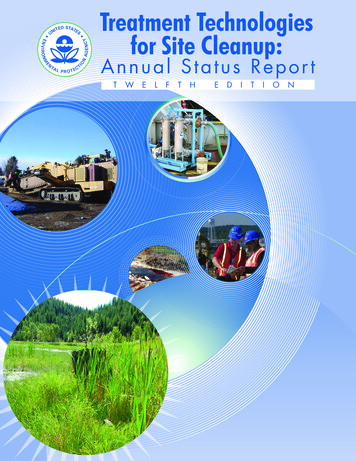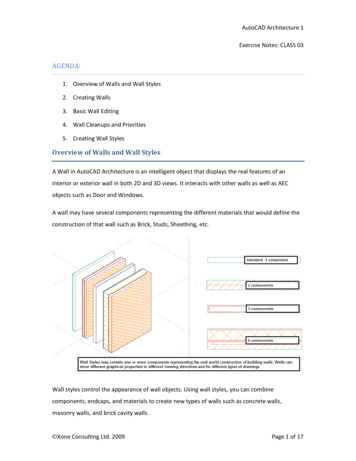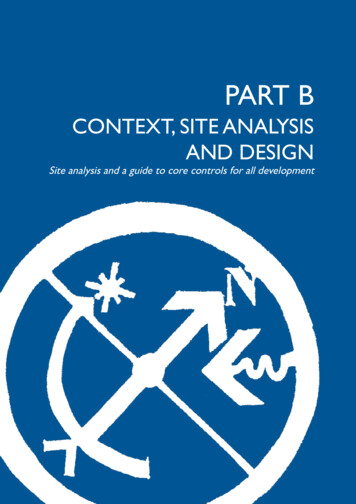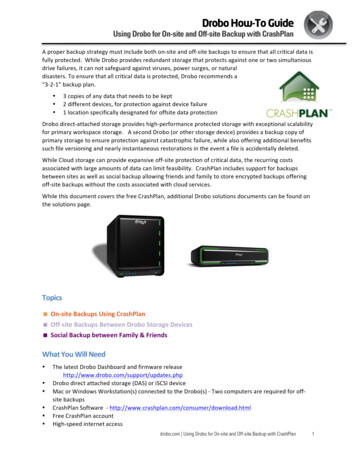
Transcription
Solid Waste andEmergency Response(5203P)EPA-542-R-07-012September 2007www.epa.gov/tiohttp://clu-in.org/asrTreatment Technologies for Site Cleanup:Annual Status Report (Twelfth Edition)
Table of ContentsTable of ContentsNOTICE . vLIST OF ACRONYMS . viEXECUTIVE SUMMARY . ES-1Section 1: Introduction .Reporting on the Status of Treatment Technologies .Treatment Technologies Included in this Report .Framework for Discussion of Treatment Technology Data .Organization of the ASR Twelfth Edition .1-11-11-21-41-7SECTION 2: OVERVIEW OF DATA . 2-1Remedies Selected in RODs . 2-2Status of Superfund Remediation Projects . 2-4SECTION 3: TREATMENT TECHNOLOGIES FOR SOURCE CONTROL . 3-1Source Control RODs . 3-2Source Control Treatment Projects . 3-3In Situ Versus Ex Situ Technologies . 3-4Status of Source Control Treatment Projects . 3-7Innovative Applications . 3-9Contaminants Addressed . 3-11Remedy Changes. 3-12Conclusion . 3-13SECTION 4: TREATMENT TECHNOLOGIES FOR GROUNDWATER . 4-1Groundwater Remedy Decisions . 4-1RODs That Select Groundwater Treatment . 4-3RODs That Select MNA . 4-8In Situ Groundwater Treatment Projects . 4-8In Situ Groundwater Treatment Remedy Trends . 4-8Status of In Situ Groundwater Projects . 4-11Groundwater Pump and Treat Projects . 4-12Status of Pump and Treat Projects . 4-13Contaminants Treated by Pump and Treat Projects . 4-13Pump and Treat Remedy Changes . 4-13Conclusion . 4-15SECTION 5: REPORT FOCUS AREA - ON-SITE CONTAINMENT REMEDIES .Collection of Data about On-Site Containment Projects .Overview of Sites with On-Site Containment .Cover Designs and Layer Components .Cover System Goals .Vertical Engineered Barriers .5-15-25-25-35-55-7SECTION 6: REFERENCES AND SOURCES OF ADDITIONAL INFORMATION . 6-1References . 6-1Online ASR Resources . 6-1iii
APPENDIX B - TREATMENT TECHNOLOGY SUMMARY MATRIXAPPENDIX C - DEFINITIONS OF SPECIFIC TREATMENT TECHNOLOGIESAPPENDIX D - TREATMENT TECHNOLOGIES: SUMMARY OF STATUS REPORT ADDITIONS,CHANGES, AND DELETIONSAPPENDIX E - RODS SELECTING MONITORED NATURAL ATTENUATIONAPPENDIX F - IDENTIFICATION OF REMEDY AND RECORD OF DECISION TYPES FORSUPERFUND REMEDIAL ACTIONSAPPENDIX G - REASONS FOR SHUT DOWN OF 73 GROUNDWATER PUMP AND TREATSYSTEMSAPPENDIX H - ON-SITE CONTAINMENT REMEDIESINDEXBoxesBox 1.New in the Twelfth Edition . 1-1Box 2.In Situ and Ex Situ Treatment . 1-2Box 3.Summary of Source Control and Groundwater Remedy Types . 1-3Box 4.NPL Sites and RODs . 1-4Box 5.Evolution of Treatment Technologies . 1-4Box 6.Reporting of ROD and Project Data in the ASR . 1-6Box 7.Classifying the Status of Projects . 2-4Box 8.Definition of a Completed Project . 2-4Box 9.Source Control Remedy Types . 3-1Box 10.In Situ Chemical Treatment at Eastland Woolen Mill, Maine . 3-6Box 11.Innovative Technologies Selected From FY 2002 Through 2005 . 3-10Box 12.Groundwater Remedy Types . 4-1Box 13.Sites with both Pump and Treat and Source Control Treatment Remedies . 4-3Box 14.Groundwater MNA . 4-7Box 15.P&T Optimization . 4-14Box 16.Information in ASR Search System . 6-2FiguresFigure 1.Actual Remedy Types at Sites on the NPL (FY 1982-2005) . 2-1Figure 2.Remedies Selected in RODs (FY 1982-2005). 2-2Figure 3.Media Addressed in RODs (FY 1982-2005) . 2-3Figure 4.Completed Treatment Projects by Remedy Type (FY 1982 -2005) . 2-5iiiiiTable of ContentsAPPENDIX A - TREATMENT TECHNOLOGIES BY FISCAL YEAR
Table of ContentsFigure 5.Projects Completed for the Most Common Technologies(FY 1982-2005) . 2-6Figure 6.Source Control RODs (FY 1982-2005) . 3-2Figure 7.Trends in Types of Source Control RODs (FY 1982-2005) . 3-3Figure 8.Source Control Treatment Projects (FY 1982 - 2005) . 3-4Figure 9.Source Control Treatment Projects (FY 2002 - 2005) . 3-5Figure 10.In Situ Technologies for Source Media (FY 1985-2005) . 3-6Figure 11.Status of In Situ and Ex Situ Source Treatment Projects Comparison Between Tenth, Eleventh and Twelfth Editionsof the ASR (FY 1982-2005) . 3-7Figure 12.Innovative Applications of Source Treatment Technologies(FY 1982-2005) . 3-9Figure 13.Established and Innovative Source Treatment Projects(FY 1982-2005) . 3-10Figure 14.NPL Sites with P&T, In Situ Treatment, or MNA Selected as Partof a Groundwater Remedy (FY 1982 - 2005) . 4-2Figure 15.RODS Selecting Groundwater Remedies (FY 1982-2005). . 4-4Figure 16.Trends in RODs Selecting Groundwater Remedies (FY 1986-2005) . 4-5Figure 17.Trends in Groundwater RODs Selecting Pump and Treat(FY 1986-2005) . 4-6Figure 18.Trends in Groundwater RODs Selecting In Situ Treatment(FY 1986-2005) . 4-7Figure 19.In Situ Groundwater Treatment Projects (FY 1982-2005) . 4-8Figure 20.Contaminant Groups Treated by In Situ Groundwater Projects(FY 1982-2005) . 4-10Figure 21.Status of In Situ Groundwater Treatment Projects - ComparisonBetween Tenth, Eleventh and Twelfth Editions of the ASR(FY 1982-2005) . 4-11Figure 22.Status of Groundwater Pump and Treat Projects (FY 1982-2005) . 4-13Figure 23.Contaminants Most Commonly Treated by Pump and TreatSystems (FY 1982-2005) . 4-14Figure 24.RODs Selecting On-Site Containment (FY 1984-2005) . 5-1Figure 25.Cover System Types for Landfills/Disposal Units and SurfaceContamination Sites . 5-4Figure 26.Cover System Sizes by Site Type . 5-5Figure 27.Secondary Goals for Conventional and Soil Caps at Landfills/Disposal Units and Surface Contamination Sites . 5-6Figure 28.Additional Remedies Used with Cover Systems . 5-7iiiiv
Table 1.Actual Source Control Remedy Types at NPL Sites (FY 1982-2005) . 3-1Table 2.RODs Selecting Source Control Remedies(FY 1982-2005) . 3-1Table 3.Status of Source Treatment Projects by Technology(FY 1982-2005) . 3-8Table 4.Contaminants Treated by Source Treatment Projects(FY 1982-2005) . 3-11Table 5.Most Commonly Changed Source Control Technologies(FY 1982 -2005) . 3-13Table 6.Actual Groundwater Remedy Types at NPL sites (FY 1982-2005) . 4-2Table 7.Sites with Groundwater Other Remedies (FY 1982-2005) . 4-3Table 8.RODs Selecting Groundwater Remedies(FY 1982-2005) . 4-3Table 9.In Situ Groundwater Treatment Projects . 4-9Table 10.Status of In Situ Groundwater Treatment Projectsby Technology (FY 1982-2005) . 4-12Table 11.Site Types for On-Site Containment Sites . 5-2Table 12.Types of Hydraulic Barriers for Conventional Caps atLandfills/Disposal Units and Surface Contamination Sites . 5-4Table 13.Types of Vertical Engineered Barriers (FY 1982-2005) . 5-8ivvTable of ContentsTables
Notice: Treatment Technologies Annual Status ReportA portable document format (PDF) version of theASR is available for viewing or downloading fromthe Hazardous Waste Cleanup Information (CLUIN) Web site at http://clu-in.org/asr. Printed copiesof the ASR can also be ordered through that webaddress, subject to availability.NoticePreparation of this report has been funded whollyor in part by the U.S. Environmental ProtectionAgency (EPA) under contract number 68-W-02034. Mention of trade names or commercialproducts does not constitute endorsement orrecommendation for use. A limited number ofprinted copies of Treatment Technologies for SiteCleanup: Annual Status Report (ASR), TwelfthEdition (EPA 542-R-07-012) is available free ofcharge from:The data for the ASR are available in a searchableonline database (the ASR Search System) athttp://cfpub.epa.gov/asr/.U.S. EPA/National Service Center forEnvironmental Publications (NSCEP)(800) 490-9198Fax: (301) 604-3408viv
ASRAnnual Status ReportBTEXBenzene, toluene, ethylbenzene, andxyleneCCConstruction completionCERCLIS Comprehensive EnvironmentalResponse, Compensation, andLiability Information SystemCode of Federal RegulationsCLU-IN EPA's CLeanUp INformation systemDCEDichloroetheneDNAPLDense nonaqueous phase liquidDREDestruction and removal efficiencyEOUExcess, obsolete, or unserviceableEPAU.S. Environmental ProtectionAgencyESDExplanation of significant differencesFRTRFederal Remediation TechnologiesRoundtableFYFiscal yearLNAPLLight nonaqueous phase liquidMNAMonitored natural attenuationMSWMunicipal solid wasteNA/NFA No action/no further actionNAPLNonaqueous phase liquidNPLNational Priorities ListNSCEPNational Service Center forEnvironmental PublicationsOBOpen detonationOSCOn-Scene CoordinatorOSRTIOffice of Superfund Remediationand Technology InnovationOSWER Office of Solid Waste and EmergencyResponseCERCLA Comprehensive EnvironmentalResponse, Compensation, andLiability ActCFRODOpen burnviiviOUOperable unitP&TPump and treatPAHPolycyclic aromatic hydrocarbonsPCBPolychlorinated biphenylsPCETetrachloroethenePCORPreliminary close-out reportPDFPortable document formatPRBPermeable reactive barrierRARemedial actionRCRAResource Conservation and RecoveryActRODRecord of DecisionRPMRemedial Project ManagerRSERemediation System fund Amendments andReauthorization ActSVESoil vapor extractionSVOCSemivolatile organic avioletVCVinyl chlorideVEBVertical engineered barrierVOCVolatile organic compoundList of Acronyms: Treatment Technologies Annual Status ReportList of Acronyms
Executive Summary: Treatment Technologies Annual Status Report Executive Summary Major FindingsUse of Treatment Remedies at NPL SitesThe Twelfth Edition of Treatment Technologies forSite Cleanup: Annual Status Report (ASR)documents the status, achievements, and trendsassociated with treatment technologies at NationalPriorities List (NPL) sites for remedy decisionsbetween 1982 and 2005. Information collectedand analyzed for this report helps document theprogress and contributions of technologiesimplemented at NPL sites. In addition topresenting information about remedy decisionsbased solely on records of decision (ROD), thisreport provides data about projects that relate totheir operational status and treatmentaccomplishments. The report includes informationabout: Treatment technologies for source control: Insitu and ex situ treatment technologies forsources of contamination (such as soil, sludge,sediment, other solid matrix wastes, andnonaqueous phase liquids [NAPL]). Treatment technologies and other remedies forgroundwater: In situ and ex situ (pump andtreat [P&T]) groundwater treatmenttechnologies and monitored natural attenuation(MNA) remedies for groundwater. On-site containment remedies: Verticalengineered barriers (VEB), caps, and liners usedto prevent the migration of contaminants orcontaminated media.This edition of the ASR provides: Information about 192 treatment technologiesselected from fiscal year (FY) 2002 to 2005(“new” for the ASR Twelfth Edition) Updates to more than 1,200 projects from 1982to 2002 A total of 1,915 treatment technologies and 57groundwater VEBs are included with updatedinformation Analysis of 133 on-site containment projects(“new” analysis for the ASR Twelfth Edition)The data contained in the report were gatheredfrom the Comprehensive Environmental Response,Compensation, and Liability Act InformationSystem (CERCLIS) for FY 1982 to 2005 (asdocumented as of October 2006), from site-specificdecision documents, and online U.S.Environmental Protection Agency (EPA) sources.The Superfund Amendments and ReauthorizationAct of 1986 (SARA) expressed a preference forpermanent remedies (that is, treatment) overcontainment or removal and disposal in theremediation of Superfund sites. As of September2005, 1,536 sites had been listed on the NPL. Ofthose, 307 sites had been deleted, leaving 1,229sites on the NPL. An additional 54 sites wereproposed for listing at that time. At nearly two-thirds of NPL sites (63 percent),source control treatment, groundwatertreatment, or both, have been implemented orare planned as a remedy for some portion ofthe site. More than a quarter of the sites (28 percent)selected treatment for both source control andgroundwater. The selected remedies do not include treatmentfor 24 percent of sites. No ROD has been issued for 13 percent of allNPL sites.Some 56 percent (1,677) of all RODs analyzed forthe ASR (2,976) contained provisions for treatmentof source media or groundwater. EPA currentlytracks the status of 1,915 projects for applicationof treatment technologies at Superfund sites,including in situ and ex situ treatment projects forboth source control and groundwater. Theseapplications include: 515 ex situ source control treatment projects(27 percent of all projects) 421 in situ source control treatment projects(22 percent) 725 P&T projects (38 percent) 213 in situ groundwater treatment projects (11percent) 41 in situ source control and in situ groundwatertreatment projects (2 percent)Use of Treatment for Source ControlA total of 977 projects were planned orimplemented for the 1,104 source controltreatment RODs and ROD amendments. Thoseprojects include a wide range of in situ and ex situtechnologies used to address many types ofcontaminants, and represent various stages ofES-2ES-1
The selection of in situ treatment for sourcecontrol continues to increase. In situ sourcecontrol treatment projects represented 60percent of source treatment projects from FY2002 to 2005. Cumulatively, from FY 1982through 2005, in situ source control projectsmake up 47 percent of the projects. From FY 2002 to 2005, projects that used insitu technologies of multi-phase extraction andchemical treatment are being selected at anincreasing rate compared with soil vaporextraction (SVE) projects that are not beingselected as frequently as in past years. Historically, incineration projects haverepresented a high percentage of ex situ sourcetreatment projects (29 percent reported in theeleventh edition of the ASR for FY 1982 to2005). During the period from FY 2002 to2005, incineration represented only 6 percentof ex situ treatment projects. In FY 2004, the percentage of projects thatselected innovative technologies reached 47percent, nearly equaling the percentage forestablished technologies. This trend continuedin FY 2005, with partial data indicating 48percent of projects selected innovativetechnologies. Nearly 80 percent of ex situ source controlprojects are completed and 10 percent areoperational. Approximately 40 percent of insitu source control projects are completed, whileanother 40 percent are operational.Use of Treatment for GroundwaterOf the RODs that select groundwater treatment,18 percent (195) used in situ treatment remedies,whereas more than 90 percent (958) used P&Tremedies. A total of 254 in situ treatment projectsand 725 P&T projects are planned or have beenimplemented from those RODs. Trends andgeneral observations about groundwater treatmentRODs and projects include: RODs that select in situ groundwater treatmenthave been generally increasing, from none inFY 1982 through 1986 to a high of 31 percentin FY 2005. RODs that select P&T alone have decreasedfrom about 80 percent before FY 1992 to anaverage of 20 percent over the last 5 years (FY2001 through 2005).ES-3ES-2 RODs that select MNA experienced a declinefrom FY 1999 to 2002, coinciding withpublication of EPA guidance on the use ofMNA in 1999. Since FY 2002, RODs thatselect MNA have been increasing, with almosthalf of all groundwater RODs selecting MNAin FY 2005. The most common in situ technologies includeair sparging, bioremediation, chemicaltreatment, permeable reactive barriers (PRB),and multi-phase extraction. Cumulatively, airsparging represents almost 30 percent of all insitu groundwater treatment projects andbioremediation represents 27 percent. In situ bioremediation and chemical treatmenthave increased significantly in recent years, withapproximately 70 to 80 percent of these projectsselected in the past six years. More than 70 percent of P&T projects selectedare currently operational. Another 10 percenthave been shut down. Eighteen percent of insitu groundwater projects have been completed,and nearly 50 percent continue to operate.Project Completion at NPL SitesA total of 1,915 treatment remedies have beenplanned or implemented at NPL sites. Of thesetreatment remedies: 687 projects (36 percent) have been completedor shut down 857 projects (45 percent) are operational 371 projects (19 percent) are being designed orconstructedTrends and general observations about completedprojects include: Approximately 60 percent of all source controlprojects are completed. Most of the completed projects are ex situ sourcecontrol treatments (57 percent) that usuallyinvolve excavation of contaminated soil andapplication of an aggressive treatmenttechnology in a controlled environment. Nearlyall incineration projects have been completed.Approximately 80 percent of the solidification/stabilization (S/S) and thermal desorptionprojects have been completed. In situ treatments are applied to contaminatedmedia in place, without excavation. Theseprojects typically require longer treatment timesbecause they take place in a less controlledenvironment, which may limit the treatmentrate. In situ treatment technologies representExecutive Summary: Treatment Technologies Annual Status Reportdesign and implementation. Trends and generalobservations include:
Executive Summary: Treatment Technologies Annual Status Report31 percent of completed projects, with 170 ofthose 216 projects being in situ source controltreatment only (with no groundwatertreatment). More in situ source control projects have beencompleted than in situ groundwater projects.For instance, approximately 65 percent of insitu S/S projects and 45 percent of in situ SVEprojects have been completed. In contrast, lessthan 30 percent of air sparging for in situgroundwater treatment have been completed. P&T projects, which represent the largestnumber of treatment projects (725), typicallyrequire long treatment times and represent only11 percent of all completed and shut downprojects. Ten percent of P&T projects have beencompleted or shut down.ES-4ES-3
BOX 1. NEW IN THE TWELFTH EDITIONSince the inception of the Superfund program, EPAhas responded to thousands of actual or potentialreleases of hazardous substances through short-termor emergency removal actions and longer-termcleanup efforts known as remedial actions. Theseremedial actions, undertaken to provide morepermanent solutions to protect human health andsafety, may require years to design, implement, andcomplete.Although remedial options may include a varietyof possible remedies, ranging from containment ofwastes to treatment to institutional controls, theSuperfund Amendments and Reauthorization Actof 1986 (SARA) expressed a preference forpermanent remedies (that is, treatment) overcontainment or removal and disposal inremediation of Superfund sites. EPA currentlytracks the status of projects where treatmenttechnologies are applied at National Priorities List(NPL) sites to collect and analyze informationabout the progress and contributions oftechnologies that have been implemented. Thisreport documents the status, achievements, andtrends associated with treatment technologies atNPL sites with remedy decisions from fiscal year(FY) 1982 through 2005. Information about 192 treatmenttechnologies selected from FY 2002 to2005 (“new” for the ASR TwelfthEdition). Updates to more than 1,200 treatmenttechnologies selected from FY 1982 to2002. A total of 1,915 treatment technologiesand 57 groundwater vertical engineeredbarriers (VEBs) are included withupdated information. Analysis of 133 on-site containmentprojects (“new” for the ASR TwelfthEdition). Treatment Technologies for Source Control In situ and ex situ treatment technologies forsources of contamination (such as soil, sludge,sediment, other solid matrix wastes, andnonaqueous phase liquids [NAPL]). Treatment Technologies and Other Remediesfor Groundwater - In situ and ex situ (pumpand treat [P&T]) groundwater treatmenttechnologies and monitored natural attenuation(MNA) remedies for groundwater. Containment Remedies - Vertical engineeredbarriers (VEB), caps, and liners used to preventthe migration of contaminants or contaminatedmedia.The Twelfth Edition of the ASR uses informationfrom the ASR Eleventh Edition (EPA 542-R-03009), published by EPA in February 2004, andupdated data from the following sources: FY 2002 decision documents (e.g., records ofdecision [ROD], ROD amendments, andExplanations of Significant Differences [ESD]).Data includes the estimated 30 percent ofdecision documents that were not included inthe ASR Eleventh Edition. FY 2003 decision documents. FY 2004 decision documents. FY 2005 decision documents available as ofOctober 2006 (an estimated 76 percent of thetotal signed decision documents). Other sources of information, including 5-yearreview reports, preliminary close-out reports(PCOR), and online regional site summaries. Repor ting on the Status ofTreatment TechnologiesThe Twelfth Edition of Treatment Technologies forSite Cleanup: Annual Status Report (ASR)documents treatment technology applications forsoil, other solid wastes, liquid wastes, andgroundwater at NPL sites. The report includesinformation about:1-11IntroductionIn 1980, Congress enacted the ComprehensiveEnvironmental Response, Compensation, andLiability Act (CERCLA, or Superfund) to addressthe dangers of abandoned or uncontrolledhazardous waste sites. CERCLA provides the U.S.Environmental Protection Agency (EPA) and otherfederal agencies the authority to respond to a releaseor a substantial threat of a release of a hazardoussubstance into the environment, or a release orsubstantial threat of a release of "any pollutant orcontaminant, which may present an immediate andsubstantial danger to public health or welfare."Section 1:Section 1: Introduction
IntroductionSection 1:SITE WITH SOURCE MEDIA ANDGROUNDWATER CONTAMINATIONInformation about technologies and sites identifiedin this report was obtained, in part, from theCERCLA Information System (CERCLIS) as ofOctober 2006. Some data may differ frominformation found in the CERCLIS database as aresult of review of individual decision documents,site summaries, or other sources obtained whilepreparing this report.Treatment Technologies Included in thisReportRemedies selected for NPL sites are documentedin RODs and ROD amendments. Throughoutthe ASR, the term "RODs" is generally usedinclusively to mean both RODs and RODamendments. Many RODs for remedial actionsaddress the source of contamination, such as soil,sludge, sediments, and solid-matrix wastes; these"source control" RODs select "source controlremedies." A groundwater remedial action is alsoknown as "a non-source control action." Theseactions are described in the report as "groundwaterremedies." The graphic at the right illustrates aremedial site with source media contamination andgroundwater contamination. A ROD may includeboth "source control" and "groundwater"components. Appendix F to this document is adetailed description of the methodology used toclassify RODs, including detailed definitions of"source control remedies," "groundwaterremedies," and other remedy types. Box 3 providesa summary of the remedy types presented inAppendix F.BOX 2. IN SITU AND EX SITU TREATMENTIn situ: In its original place; unmoved,unexcavated; remaining at the site or inthe subsurface.In situ treatment technologies treat orremove the contaminant from sourcemedia without excavation or removal ofthe source media, or from groundwaterwithout extracting, pumping, or otherwiseremoving the groundwater from theaquifer.Ex situ: Moved, excavated, or removedfrom the site or subsurface.Implementation of ex situ remediesrequires excavation or removal of thecontaminated source media or extractionof groundwater from an aquifer beforetreatment may occur above ground.The term "treatment technology" means any unitoperation or series of unit operations that altersthe composition of a hazardous substance orpollutant or contaminant through chemical,biological, or physical means so as to reducetoxicity, mobility, or volume of the contaminatedmaterials being treated. Treatment technologiesare an alternative to land disposal of hazardouswastes without treatment (March 8, 1990 FederalRegister [55 FR 8819], see Title 40 Code of FederalRegulations [CFR] Part 3
Edition (EPA 542-R-07-012) is available free of charge from: U.S. EPA/National Service Center for Environmental Publications (NSCEP) (800) 490-9198 Fax: (301) 604-3408 A portable document format (PDF) version of the ASR is available for viewing or downloading from the Hazardous Waste Cleanup Informati










